Versilia
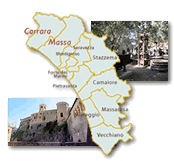
Bordered by the Tyrrhenian Sea on the west and the Apuane Alps on the east, in the radius of few kilometres Versilia offers an extraordinary variety of landscapes and a multiplicity of historical tokens, which range from the Palaeolithic to the present day. Though focused on the area of Upper Versilia, the proposed itinerary intends to offer a general picture of this territory’s wealth.
The mandatory point of departure is Massa, capital city of the province, dominated by the powerful Malaspina Castle, a large complex, fruit of the centuries-old stratification of structures, which offers a cross-section of military from the 11th century to the 16th century.
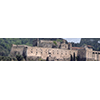
The stately castle that still today dominates the city of Massa owes its present appearance to numerous building phases that followed each other in time, staring from a fortified curtis dating to the 11th century. Contended by numerous potentates, it was transformed into a genteel residence by the Malaspina family which took possession of it towards the mid 15th century. Despite the modifications it underwent, the complex maintained its original defensive function through time, also thanks to its bailey which englobed the medieval keep and the marquises’ palace.
Still today, the impressive structure can be admired with its two bastions, the rows of embrasures, and the complex and efficient defence system of the castle’s only access. Among its architectural curiosities, note the peculiarity of the fourteenth-century keep, which is outstanding for being constructed directly in the rock and not in masonry.
(Elena Fani)
Also on the city’s territory, a worthwhile visit is the Museo Etnologico delle Apuane "Luigi Bonacoscia", which preserves one of the vastest ethnographic collections in Tuscany.
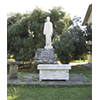
The Museo Etnologico delle Apuane, housed in two buildings in the vicinity of the Sanctuary of the Madonna degli Uliveti, is dedicated to the local culture along the coasts of Lunigiana. It was founded in 1980 at the initiative of Don Luigi Bonacoscia and the Associazione "Movimento di Umanesimo Sociale per la nobiltą del lavoro umano" [Association "Social Humanism Movement for the Nobility of Human Labour"], under the name of Museo Etnologico Apuano "Ernesto Masnata". The original core consisted of the Masnata private collection, made up of some 300 objects collected during World War I in the Lunigiana territory, and the collection belonging to the "Social Humanism Movement", comprised of around 100 objects. The collection has been enlarged through research carried out by Luigi Bonacoscia in the Provinces of Massa-Carrara, Versilia and Garfagnana.
Today the museum displays one of the richest and most complete collections in Tuscany, as regards both the quantity of objects and the variety of the subjects dealt with. The ethno-anthropological collection, arranged in 32 sections, includes implements for work, industrial and agricultural means and objects of various kinds pertinent to the production activity and the daily life of the local population. The objects date from the 19th and 20th centuries. Along with documentation on domestic, rural and craftsmen's activities, the exhibition also displays testimony of the activities of and mining and working marble.
(Antonella Gozzoli)
The tour continues with a visit to the Aghinolfi Castle in Montignoso, near Massa, which exceptionally conserves intact its complex water supply system built in the 15th century.
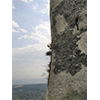
Known from documents since the 8th century A.D., the Aghinolfi Castle is an exceptional example of medieval military architecture, which attracted the attention of scholars already in the 19th century. The castle’s complex water supply system dating to the mid 15th century is particularly interesting for the knowledge of hydraulic technology. On the roof terrace of the octagonal keep, the original terracotta canalizations that collected water to convey it to the cistern were repristinated on the occasion of the 2001 restoration. Thanks to a glass floor, the bottom of the cistern exhibits copies of ceramic containers (the originals found there date to the late 16th century).
(Elena Fani)
Though recently founded, the Orto Botanico delle Alpi Apuane "Pietro Pellegrini" is known nationally for the reconstruction of numerous biotopes, including an experimental arboretum of conifers. It is reached backtracking towards Massa and turning left on Via Bassa Tambura/SP5 and then Via dei Colli/SP4.

The Botanical Garden was instituted in 1966 in the locality of Pian della Fioba. Situated in a rocky area, some 900 metres a.s.l., it is traversed by a footpath that winds through its various sections, and hosts spontaneous species of the Apuane Alps, typical of calcareous peaks, siliceous peaks and wetlands. Worthy of note are an experimental arboretum of conifers, a wetland for hygrophilous species, a vaccinium grove with bilberries and associated species, and a chestnut cultivar.
Dedicated to physician and botanist Pietro Pellegrini from Mass, the Garden has been the object of study by Italian and foreign researchers, and venue of numerous conferences. It has been open to the public since 1981 and is managed by the Commune of Massa in collaboration with the three Universities of Tuscany, whose representatives sit on the technical-scientific committee.
(Anna Toscano)
Massa was also the point of arrival of the daring Via Vandelli, built in the 18th century by the homonymous mathematician to connect the capital of the Duchy, Modena, with its only outlet on the sea. You can travel its winding course starting from Resceto, reachable after 12 km on SP5, through the hamlet of Guadine and Nucleo Gronda.
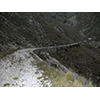
Created by order of Francesco III d’Este, the Via Vandelli was built with the precise intention of ensuring the Duchy of Modena an outlet to the sea, connecting its capital to Massa. Commissioned to court mathematician Domenico Vandelli, its realisation took many years (1738-1751), due to the ruggedness of the terrain and the adverse climatic conditions. Despite the employment of workers from Piedmont specialised in building dry walls to retain the steepest tracts of the road, the imperviousness of the stretch that crossed the Apennines and the Apuane Alps, made it difficult to use and led to its early abandonment.
Thanks to the interest of neighbouring towns, the road was restored by the Comunitą Montana in recent years. An ideal destination for cycling excursions, it offers views of rare beauty and numerous tokens of the technical solutions adopted in the 18th century, such as the so-called "Vandelli Window", cut out in the rock, which served stagecoaches as a stopover point.
(Elena Fani)
****************************
Texts by Elena Fani
English translation by Victor Beard
Last update 25/feb/2008



 = libraries and archives
= libraries and archives  = scientific research centers
= scientific research centers  = memorial places of scientists
= memorial places of scientists = public health places
= public health places = places of science and worship
= places of science and worship = places of technology
= places of technology  = museums and collections
= museums and collections  = villas and gardens of science
= villas and gardens of science


